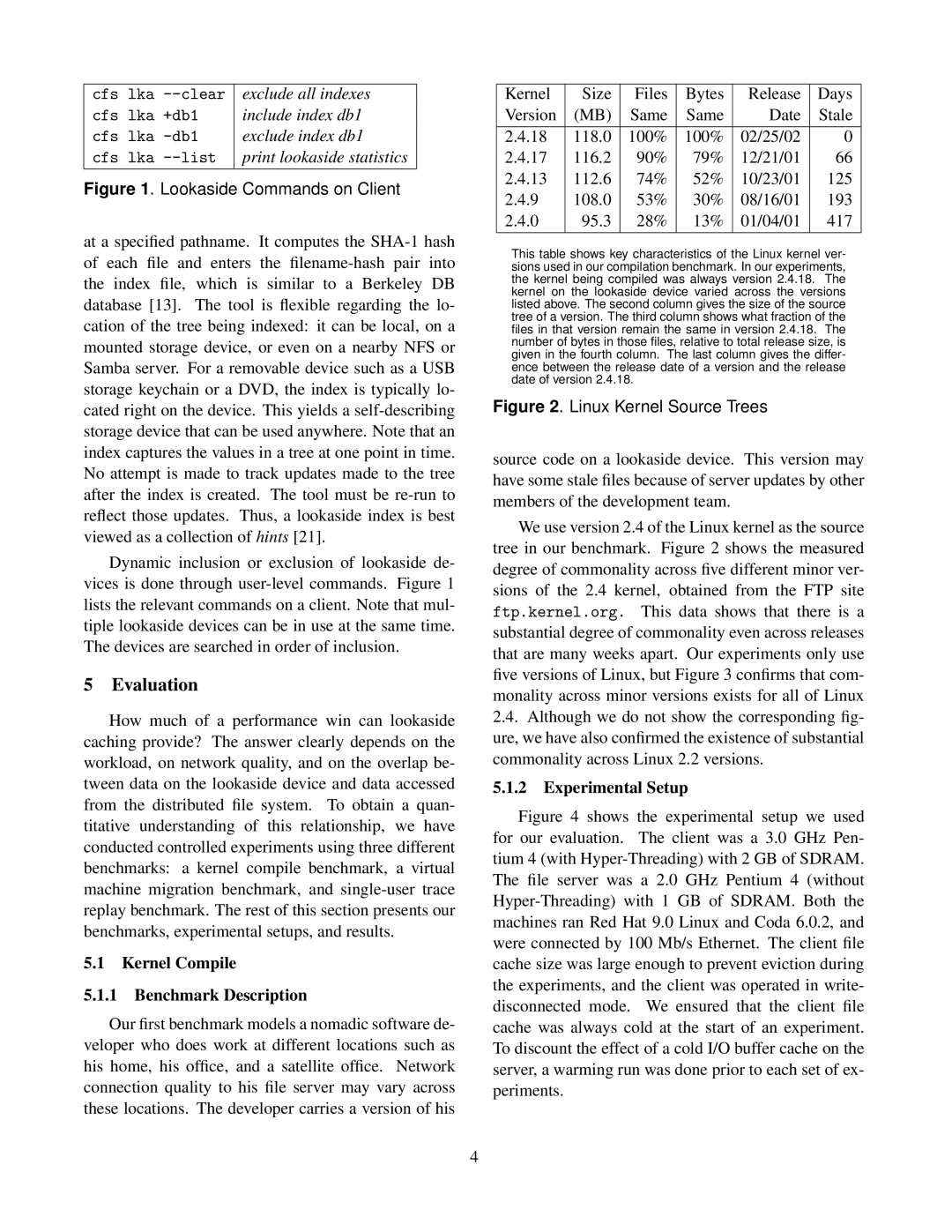
cfs lka | exclude all indexes | ||
cfs lka +db1 | include index db1 | ||
cfs | lka | exclude index db1 | |
cfs | lka |
| print lookaside statistics |
|
|
|
|
Figure 1. Lookaside Commands on Client
at a specified pathname. It computes the
Dynamic inclusion or exclusion of lookaside de- vices is done through
5 Evaluation
How much of a performance win can lookaside caching provide? The answer clearly depends on the workload, on network quality, and on the overlap be- tween data on the lookaside device and data accessed from the distributed file system. To obtain a quan- titative understanding of this relationship, we have conducted controlled experiments using three different benchmarks: a kernel compile benchmark, a virtual machine migration benchmark, and
5.1Kernel Compile
5.1.1Benchmark Description
Our first benchmark models a nomadic software de- veloper who does work at different locations such as his home, his office, and a satellite office. Network connection quality to his file server may vary across these locations. The developer carries a version of his
Kernel | Size | Files | Bytes | Release | Days |
Version | (MB) | Same | Same | Date | Stale |
2.4.18 | 118.0 | 100% | 100% | 02/25/02 | 0 |
2.4.17116.2 90% 79% 12/21/01 66
2.4.13112.6 74% 52% 10/23/01 125
2.4.9108.0 53% 30% 08/16/01 193
2.4.0 95.3 28% 13% 01/04/01 417
This table shows key characteristics of the Linux kernel ver- sions used in our compilation benchmark. In our experiments, the kernel being compiled was always version 2.4.18. The kernel on the lookaside device varied across the versions listed above. The second column gives the size of the source tree of a version. The third column shows what fraction of the files in that version remain the same in version 2.4.18. The number of bytes in those files, relative to total release size, is given in the fourth column. The last column gives the differ- ence between the release date of a version and the release date of version 2.4.18.
Figure 2. Linux Kernel Source Trees
source code on a lookaside device. This version may have some stale files because of server updates by other members of the development team.
We use version 2.4 of the Linux kernel as the source tree in our benchmark. Figure 2 shows the measured degree of commonality across five different minor ver- sions of the 2.4 kernel, obtained from the FTP site ftp.kernel.org. This data shows that there is a substantial degree of commonality even across releases that are many weeks apart. Our experiments only use five versions of Linux, but Figure 3 confirms that com- monality across minor versions exists for all of Linux
2.4.Although we do not show the corresponding fig- ure, we have also confirmed the existence of substantial commonality across Linux 2.2 versions.
5.1.2Experimental Setup
Figure 4 shows the experimental setup we used for our evaluation. The client was a 3.0 GHz Pen- tium 4 (with Hyper-Threading) with 2 GB of SDRAM. The file server was a 2.0 GHz Pentium 4 (without Hyper-Threading) with 1 GB of SDRAM. Both the machines ran Red Hat 9.0 Linux and Coda 6.0.2, and were connected by 100 Mb/s Ethernet. The client file cache size was large enough to prevent eviction during the experiments, and the client was operated in write- disconnected mode. We ensured that the client file cache was always cold at the start of an experiment. To discount the effect of a cold I/O buffer cache on the server, a warming run was done prior to each set of ex- periments.
4
